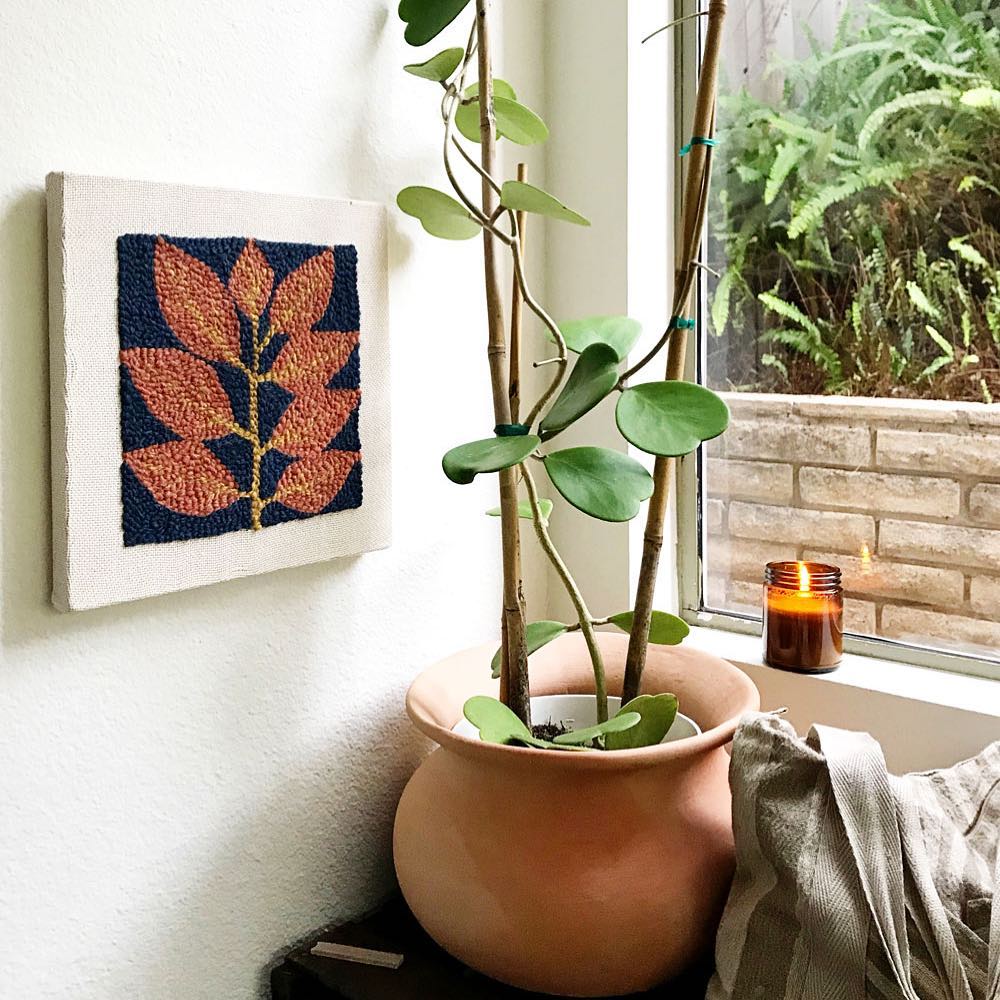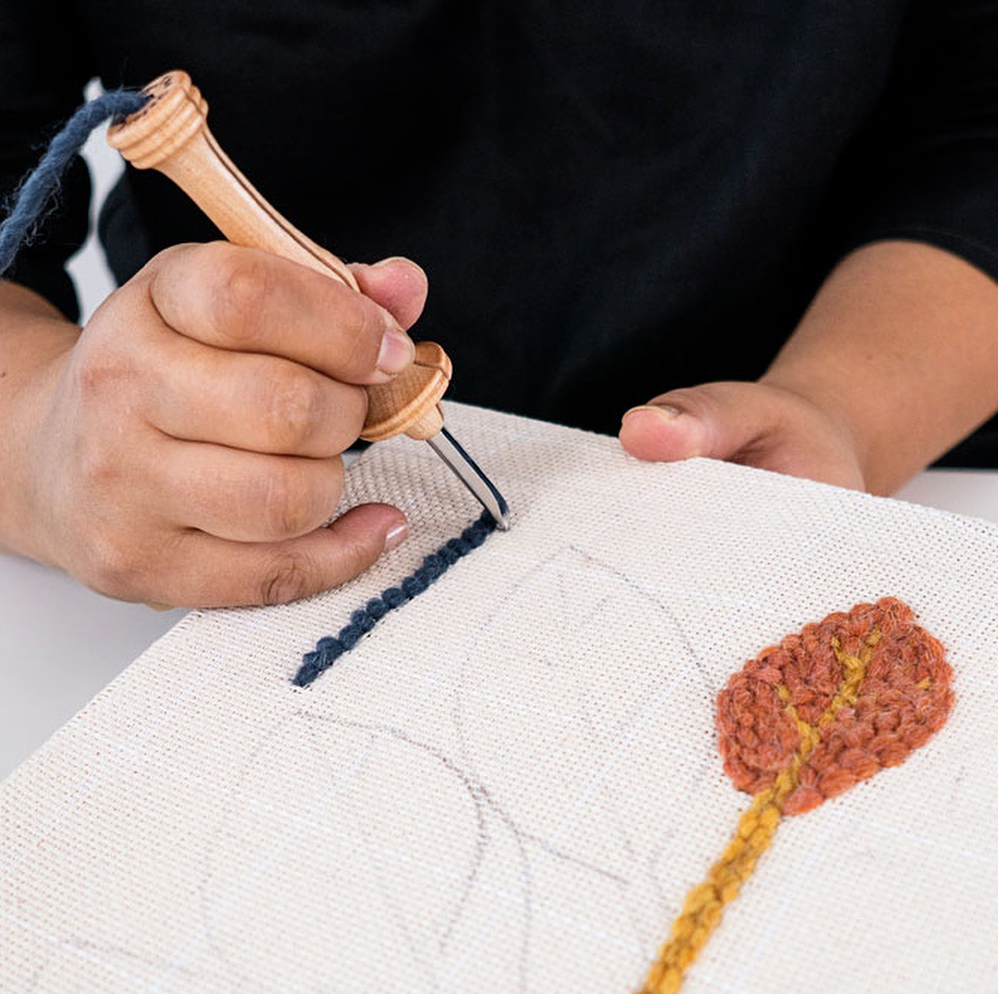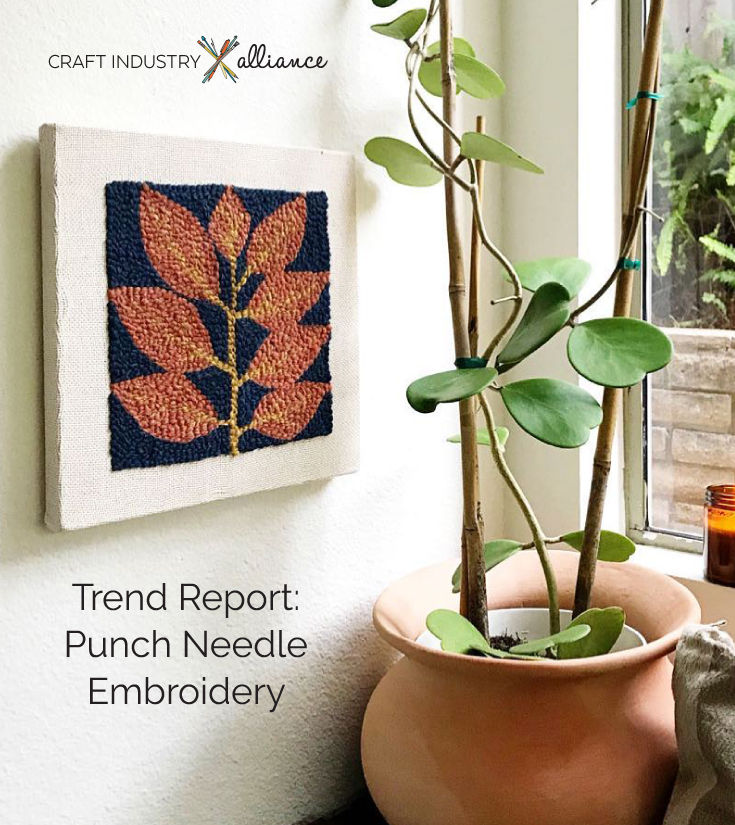
Punch needle canvas on display.
Photos courtesy of The Crafter’s Box.
Punch needle embroidery, or rug hooking, is seeing a surge of interest fueled perhaps by the recent revival of macrame and loom weaving. Receiving double the number of daily search queries compared with just two years ago, the punch needle trend seems to have spiked around September of 2017, and has remained steady ever since. Punch needling is one of the oldest non-woven yarn crafts—but why has the art form suddenly flooded our Instagram feeds?
A cousin to the medieval technique of “igolochkoy,” or Russian punch-needle embroidery, the punch needle technique was traditionally used to decorate household furnishings and clothing with fine embroidery floss. Using a sharp hollow needle to punch thread through a cloth, looped thread designs could be created from scratch or by following a pattern. The punch needle tool was adapted in 1881 by Ebenezer Ross in Toledo, Ohio, to accommodate thicker yarns for creating decorative rugs. Ross’s tool was called “The Griffin,” and made it possible to create punch needle projects with either yarn or strips of fabric.
Punch needles create textiles with a similar look to rug hooking. Although the resulting running loop stitch is identical, the processes differ, and require different tools. Modern crafters have adopted the technique as a way to create their own home decor, and the trend has taken off on Etsy and Instagram. The hashtag for #punchneedle on Instagram currently features 23K+ posts—remarkable for a craft that was revitalized less than a year ago.
Amy Oxford is widely credited for leading the punch needle renaissance, after creating her own punch needle tool, the Oxford Punch Needle, in 1995. Oxford’s website has become a resource for information about punch needle crafting, and lists workshops from Oxford-certified instructors in over 30 cities in the US, Canada, and the United Kingdom.

Punch needle supplies.
Arounna Khounnoraj of Bookhou has become a punch needle authority at the forefront of the punch needle resurgence. With a new punch needle class on Creativebug, and a recent punch needle workshop with The Crafter’s Box, Khounnoraj has set herself apart as a master of this craft technique, despite only picking up the craft in 2017 after Ness Lee gifted her the Oxford Punch Needle.
Amy Oxford traces the spike in punch needle interest to a viral Instagram post from Bookhou that featured the technique. Oxford’s team of four employees has been overwhelmed by the sudden popularity of her tool. In an interview with Deanne Fitzpatrick, Oxford shared her gratitude for the support, but added, “It’s incredibly stressful to go from being a rug maker and a teacher who sold a few punch needles on the side, to being a full-fledged manufacturer. We’re getting requests from all over the world for wholesaleing.”

Creating with a punch needle.
Bookhou’s 150K instagram followers can’t seem to get enough punch needle projects, either. The appeal might be linked to the resurgence of other textile mediums, combined with the simplicity of the tools involved. “The punch needle technique is very forgiving and also accessible, allowing people to try it out and gain a certain success in a project without a huge commitment,” Khounnoraj explains. “I think techniques like macrame and weaving have that similar quality of being able to achieve a result quickly on a certain scale. The punch needle technique has a nice balance between traditional tapestry and modern design, and the process isn’t intimidating.”
Other makers gravitate to the medium because of the quick project turnaround. “I know I became interested in punch needle work because I could see my progress so quickly,” says Emily Primbs, owner of playful textile studio Loomshakalaka, “I could jump from one area to another, or change something if I needed to without having to undo rows of work. It’s a crafting medium that is very forgiving and can easily be set aside and picked up again. I think it’s especially appealing for modern crafters because of that accessibility. You only need one tool, some yarn, and a visual idea—and the possibilities are endless.”
The resurgence of punch needle projects has surprised even industry insiders. Koel Magazine, a quarterly publication covering modern yarn crafting, featured the trend in Issue 5, released in March of 2018. “Punch needling is back, in a big way. Honestly, we have no clue where this sudden renaissance came from (how could we possibly not have predicted it), but punch needling seems to be crowding out other yarn crafts at a pretty fast clip.”
It took two decades for the Oxford Punch Needle to enter the spotlight, but why does punch needle have such appeal? “I think the punch needle renaissance is long overdue,” says Hart of Sublime Stitching. “It looks so beautiful and chunky, and seems easy, repetitive and relaxing. It offers a lot as a comforting activity. I think we can all agree that ‘relaxing while making something’ is the dragon we all chase. Punch needle hits that spot really nicely.”
Amy Oxford revels in the art form’s newfound success. “It’s so exciting to see punch needle grow. The Instagram community is wonderful! Seeing people have so much fun with it is fabulous.”

The Oxford Punch Needle.

Erin Dollar
Contributor
Erin is the textile designer and artist behind the home décor company, Cotton & Flax. She licenses her surface designs for fabric, home décor, stationery, and other clients. She’s also a teacher, writer, and enthusiastic advocate for small creative business owners. She lives in San Diego, California.


Trackbacks/Pingbacks